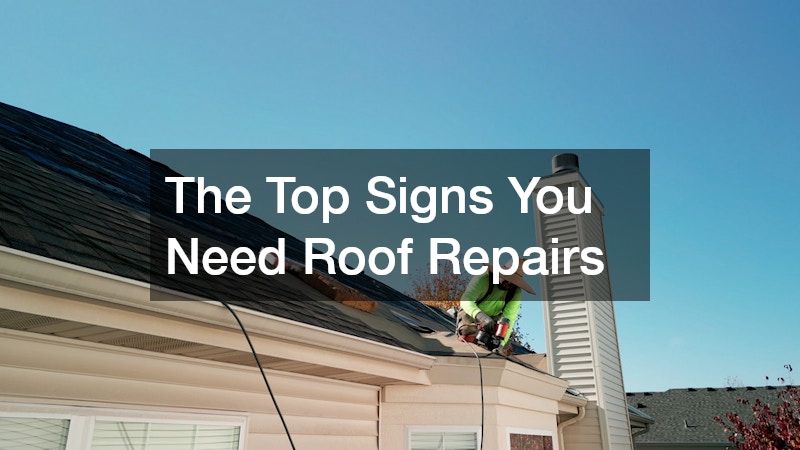
Your roof is one of the most critical components of your home, protecting your family, belongings, and the structure itself from the elements. Despite its importance, it’s easy to overlook signs of damage until it becomes a significant problem. Identifying early warning signs and addressing them promptly can save you from costly repairs or even a full roof replacement. Here are the top signs you need roof repairs.
Leaks and Water Damage
One of the most obvious indicators that your roof requires attention is the presence of leaks or water stains inside your home. Water may appear on ceilings, walls, or around vents and skylights.
Even small leaks can lead to extensive damage over time, including mold growth and structural weakening. If you notice water stains or experience dripping during rain, it’s crucial to call a roofing professional immediately to inspect and repair the affected areas.
Missing or Damaged Shingles
Shingles protect your roof from rain, wind, and sun exposure. Missing, cracked, or curling shingles are a clear sign that your roof is compromised. High winds, severe weather, and aging can cause shingles to deteriorate. If you notice bald spots or shingles in your yard after a storm, it’s a warning that your roof may need repair. Ignoring damaged shingles can lead to leaks and further structural damage.
Granules in Gutters
Asphalt shingles age, they lose protective granules. These granules often end up in your gutters. If you notice an excessive amount of granules, it may indicate that your shingles are wearing out and losing their protective layer. This is a sign that your roof may be nearing the end of its lifespan and could require repairs or replacement soon. Regular gutter inspection can help catch this early.
Sagging Roof Deck
A sagging roof is a severe warning sign that should never be ignored. Sagging indicates that the roof deck may be compromised due to prolonged water damage, structural issues, or weakened support beams. This problem not only affects the roof’s integrity but also poses safety risks for your household. If you notice any sagging areas, it’s critical to contact a professional roofer immediately to assess the damage and recommend repairs.
Moss, Algae, or Fungus Growth
Moss, algae, or fungus growth on your roof can lead to moisture retention, which accelerates shingle deterioration. While moss and algae may seem harmless at first, they can lift shingles and allow water to penetrate the roof structure. Fungus or mold growth is also a sign of excess moisture and potential leaks. Regular roof cleaning and inspection can prevent these issues from causing long-term damage.
Cracked Flashing
Flashing is the metal or material that seals roof joints around chimneys, vents, and skylights. Over time, flashing can crack, warp, or pull away from the roof. Damaged flashing allows water to seep into your home, potentially causing leaks and water damage. Inspecting flashing for signs of wear and replacing it when necessary is an essential step in maintaining your roof’s integrity.
Daylight Through the Roof
While not a common occurrence, seeing daylight through the roof from the attic is a clear indicator that your roof has gaps or holes. These openings compromise the roof’s ability to keep water and debris out. If you notice any light coming through your roof, it’s a serious sign that immediate repairs are needed to prevent water damage and further structural issues.
High Energy Bills
An often-overlooked sign of roof damage is a sudden increase in your heating or cooling costs. Poor roof insulation due to damaged or missing shingles, leaks, or ventilation problems can allow heat to escape in the winter and enter during the summer. This inefficiency forces your HVAC system to work harder, increasing energy consumption. If you notice rising energy bills without a clear explanation, consider having a professional inspect your roof.
Ice Dams in Winter
In colder climates, ice dams can form at the edge of the roof, preventing melting snow from draining properly. These dams can force water under shingles, leading to leaks and water damage inside the home. Ice dams often indicate poor insulation or ventilation, and addressing them promptly can prevent long-term roof problems.
Visible Wear and Tear
Finally, general wear and tear such as faded, blistering, or cracked shingles, rusted flashing, or deteriorating roofing materials are clear signs that your roof may need repairs. Regular visual inspections, especially after storms or extreme weather, can help you catch problems early and maintain your roof’s longevity.
Your roof protects your home, family, and belongings, so ignoring signs of damage can have serious consequences. Leaks, missing shingles, sagging areas, moss growth, damaged flashing, and even rising energy bills are all warning signs that your roof may need repairs. Regular inspections and prompt attention to these issues can extend your roof’s lifespan, prevent costly damage, and ensure your home remains safe and secure. Don’t wait until small problems become major repairs—contact a professional roofing contractor at the first sign of trouble to protect your investment.

